Gameplay
Sections:
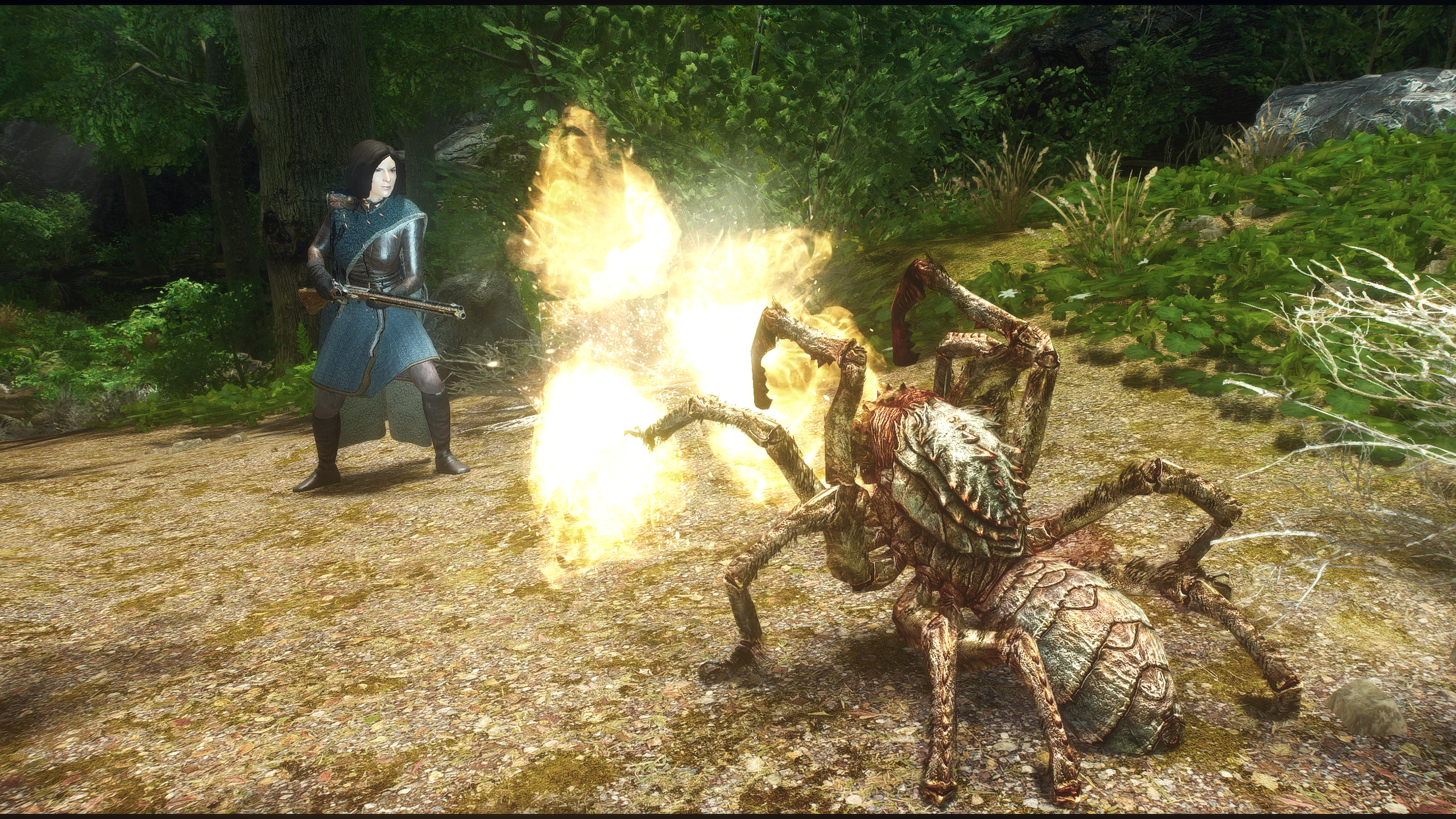
Somnium is designed to be played in third person. Great effort has been made to bring this game into the modern feel of popular action games. You are able to lock on to targets, dodge with a keypress, your rifles have a proper aiming line so that you can easily tell where you will hit while in third person, and your power attacks or off-hand attacks are accomplished by holding down a modifying-key in combination with the attack rather than a held normal input.
There are many unique and, in some cases complex, mechanics in Somnium. There are now two options to learn the specifics of all the mechanics. First, make sure to check out the help menu inside the game! You can find it by simply opening the pause menu (pressing Esc). Second, there are now Whispering Stones that have been placed by other Prophets from other eventualities around the intro and tutorial areas. These messages give you a small amount of experience and, more importantly, elucidate many of the complex mechanics that you will encounter. Seek them out and learn about the world you are about to irrevocably change with your decisions.
Controls
Somnium is playable in third person from beginning to end, and this is the designed method of play. Since the 1.1 update, we have allowed the player to switch to first person mode (Default key: P), as long as their weapons are sheathed.
However, these changes also brought necessary changes to the base controls of the game. Somnium adds elements from other genres into the world of Vyn, and many of these elements come with a standardized expectation of controls from players.
Take, for instance, guns. Somnium adds a vast array of firearms for the character to wield, and these require ammunition to be loaded for use. Most modern games use the 'R' key to reload their firearms; this has become an assumed norm. But in Enderal, Skyrim, and most other Bethesda games, the 'R' key is used to draw and stow weapons. We decided that having the 'R' key control reload was more important than drawing/stowing, and so the vanilla keybind for draw/sheathe needed to be changed and it is now bound to the 'T' key.
The controls for Somnium were decided after significant playtesting and deliberation, and we ended up with what we felt was the most comfortable blend of expectation and function that we could find.
The image below shows the default control set-up for Somnium.
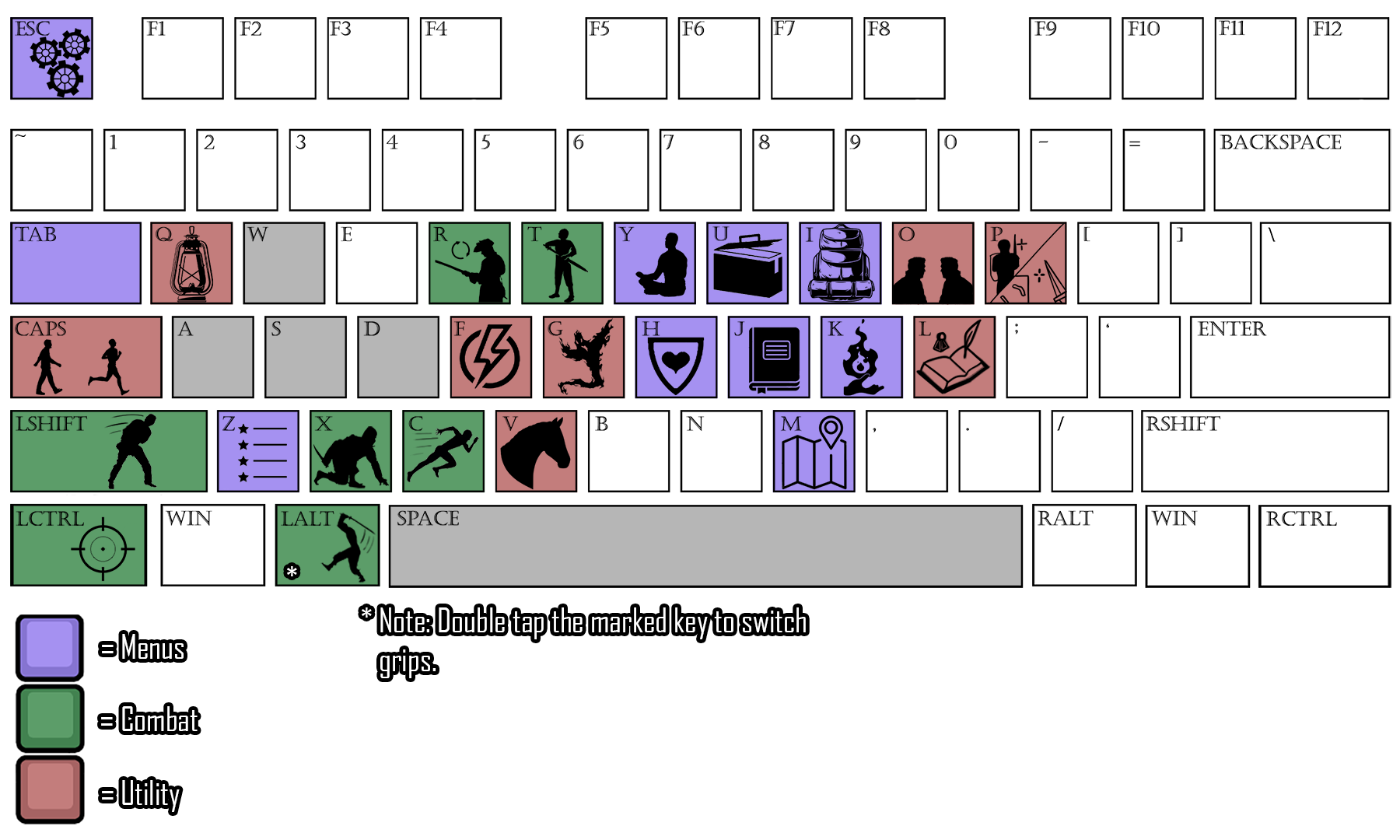
You can bring up this image in-game at any time by pressing the 'Page Down' key. Do note, however, that this is a static image and it will not change to reflect any alterations you might make to the controls.
The image color codes sections to reflect generalized groupings of use. Purple are menu keys, Green are combat keys, and Red are utility keys. Gray/Black keys are for basic movement. Going through this image I will quickly list the actions each icon connects to:
Purple
- Starting at the top left we have the 'Escape' key, which does as you would expect and opens the settings menu for the game. You will notice that the options here may not match what you are used to, we will discuss that in the
Death-reference-labelsection. - Below that is the 'Tab' key which opens the typical middle-menu for Enderal allowing you to choose between the Inventory, Map, and Magic sections.
- The 'Z' key opens your favorites menu while you are exploring.
- The 'Y' key uses your meditation power, which takes you to and from the shrine area to spend your memory, skill, and craft points after you level up.
- The 'U' key opens your ammo pouch, allowing you to equip different forms of ammunition for your guns.
- The 'I' key opens the Inventory screen without needing to enter the middle-menu.
- The 'H' key opens the Hero menu, which shows the player their character's stats, fever level, and current XP.
- The 'J' key opens the player's Journal, showing your quests.
- The 'K' key opens the Magic screen without needing to enter the middle-menu.
- The 'M' key enters opens the Map screen without needing to enter the middle-menu.
- And the 'End' key opens a notebook for you to take in game notes if you would like.
Green
- The 'R' key primarily reloads your equipped firearm. If you have no selected ammunition currently, the key will instead open the Ammo Pouch for you to select an ammunition first.
- The 'Left Shift' key activates your dodge.
- The 'C' key changes your movement from running to sprinting.
- The 'Left Control' key allows you to lock on to an enemy.
- And the 'Left Alt' key serves as a modifier, and only works when holding a melee weapon. Pressing LMB while holding down Alt will cause you to perform a Power Attack. Pressing RMB while holding Alt will allow you to attack with the weapon in your left hand, whether it is a pistol or a magic spell. Quickly double-tapping Alt will change the Grip on your melee weapon. What that does, is switch the attack style of said weapon from one-handed to two-handed, and vice-versa.
Red
- The 'Q' key activates your belt-light, illuminating dark areas, and partially protecting you from the effects the darkness might have on your sanity.
- The 'F' key activates your equipped talent (read: Power).
- The 'G' key calls your Apparition if you use the Phasmalist tree.
- The 'V' key calls your mount, assuming you have a mount.
Extra
- The 'T' key draws and stows your equipped weapon.
- The 'O' key toggles a shoulder swap, allowing you to choose which angle of third person you want to be using at any given time
- The 'P' key toggles your POV, as long as your weapons are sheathed.
- The Scroll Wheel will allow you to quickly choose between targets while the lock on is active.
- The 'Caps Lock' key will switch between your run and walk movements.
- And the 'Right Alt' key will toggle auto-move on and off.
Death
Somnium is designed to be a challenging action/thriller experience. Combat is dangerous for all parties involved and the player has a greatly expanded suite of options they can use to build their character up against the dangers. In the beginning you might die fairly often, you are weak and have the fewest tools at your disposal.
In Somnium, death does not toss you back to a previous save. Instead, dying causes you to resurrect back at the last Earthen Reliquary that you activated.
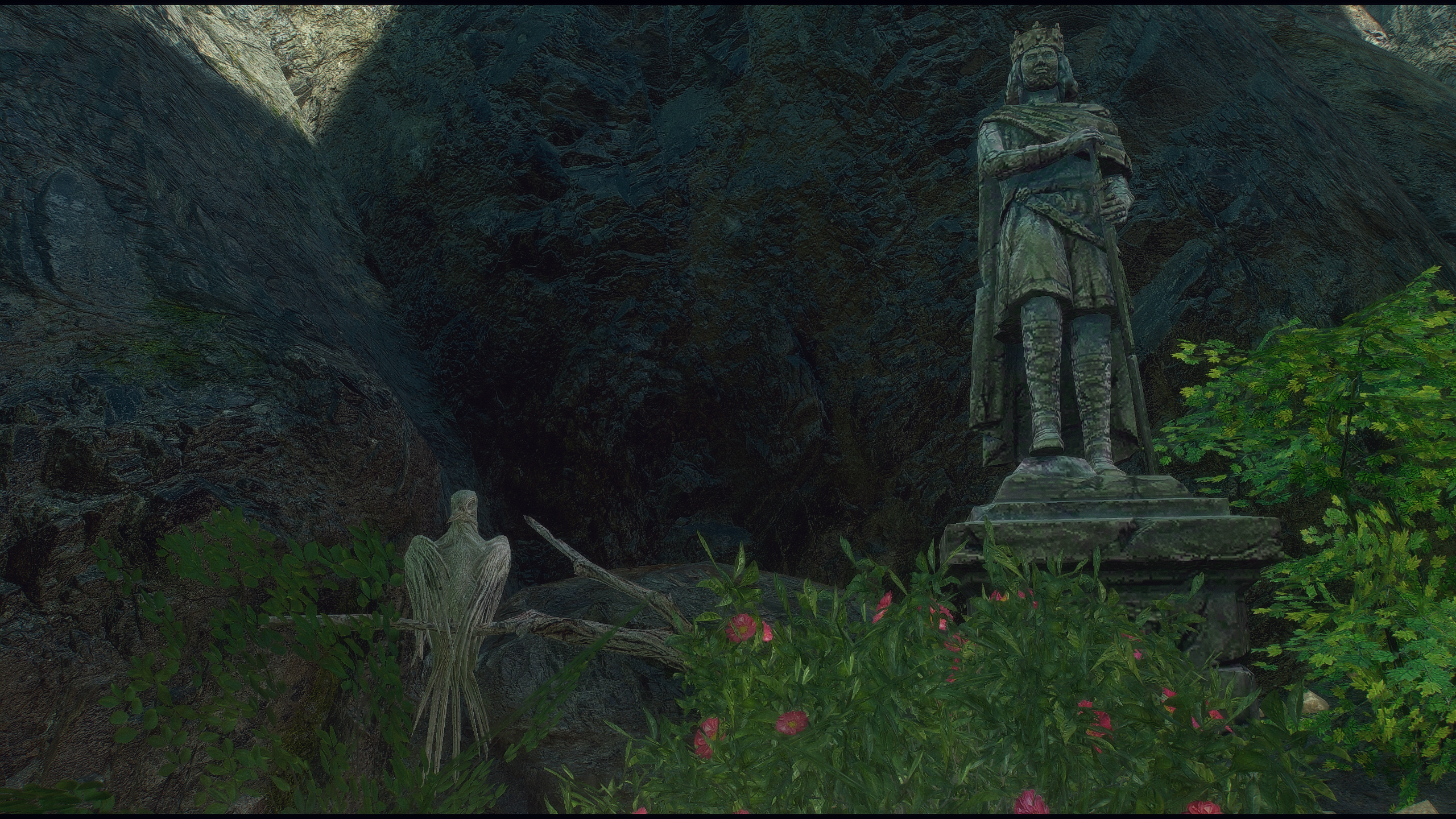
No one else even seems capable of noticing these petrified birds, nor do they seem to hear their rumbling call. But as you stand before them you can feel the power and sorrow of other lives, of other worlds, rolling upon you like gentle waves of some distant Sea.
These avian shrines act as checkpoints. You are able to open an unlimited storage and restore your Humanity at any shrine you find using the Memories of Life you obtain as you explore.
The Reliquaries utilize a shared storage, allowing you to pile your loot into them while out exploring and then draw it out in batches to sell back in town or take with you into the next stage of the crypt you are exploring. You can also store useful preparation equipment such as buffing potions and the, now-heavy, Ambrosia.
The wait function is limited to these shrines as well. If a quest requires you to be somewhere at a specific time of day, you can quickly pass the time at a nearby shrine and make it to the location. Be careful when doing so, however! Spending too much time at a reliquary or a bed may cause you to get the Rested effect, which lasts proportionally to the amount of time you've slept, thus stopping you from abusing certain mechanics related to the time. Lastly, the wait function is only possible during the day and once night falls you will be unable to pass the time safely until the next morning.
Humanity
Restoring your Humanity is an important function of the Reliquaries. As you die, your humanity is sapped from you based on the Fever level you held when you died. If your Humanity is ever completely lost, your story ends permanently.
Characters can restore their humanity at Earthen Reliquaries by sacrificing a Memory of Life. These are fragments of other lives and distant times. The reliquaries grant you a glimpse of their old lives on your first visit to every shrine, and there are certain powerful entities in the world of Enderal that possess immensely strong memories should you be able to defeat them. These powerful memories now have a dual purpose, you can sacrifice them for a larger recovery of humanity OR you can absorb some of the accumulated knowledge of the entity to give yourself more talent uses per day (explained in further detail in the Combat section).
Saving
Players will quickly notice that the settings menu no longer offers a Save function. The Earthen Reliquaries operate as your save points. Every time you back out from an Earthen Reliquary's menu your game will be automatically saved. This usually only takes a moment, and you will receive a notification when the game has completed saving. Please do not close the game while it is saving.
The game also autosaves your progress every minute, making sure that you don't lose any progress should you need to log off without a shrine nearby. Because of this, you cannot ever go back in time. Any mistakes you make, or victories you achieve, will be a permanent part of your character's history.
Combat
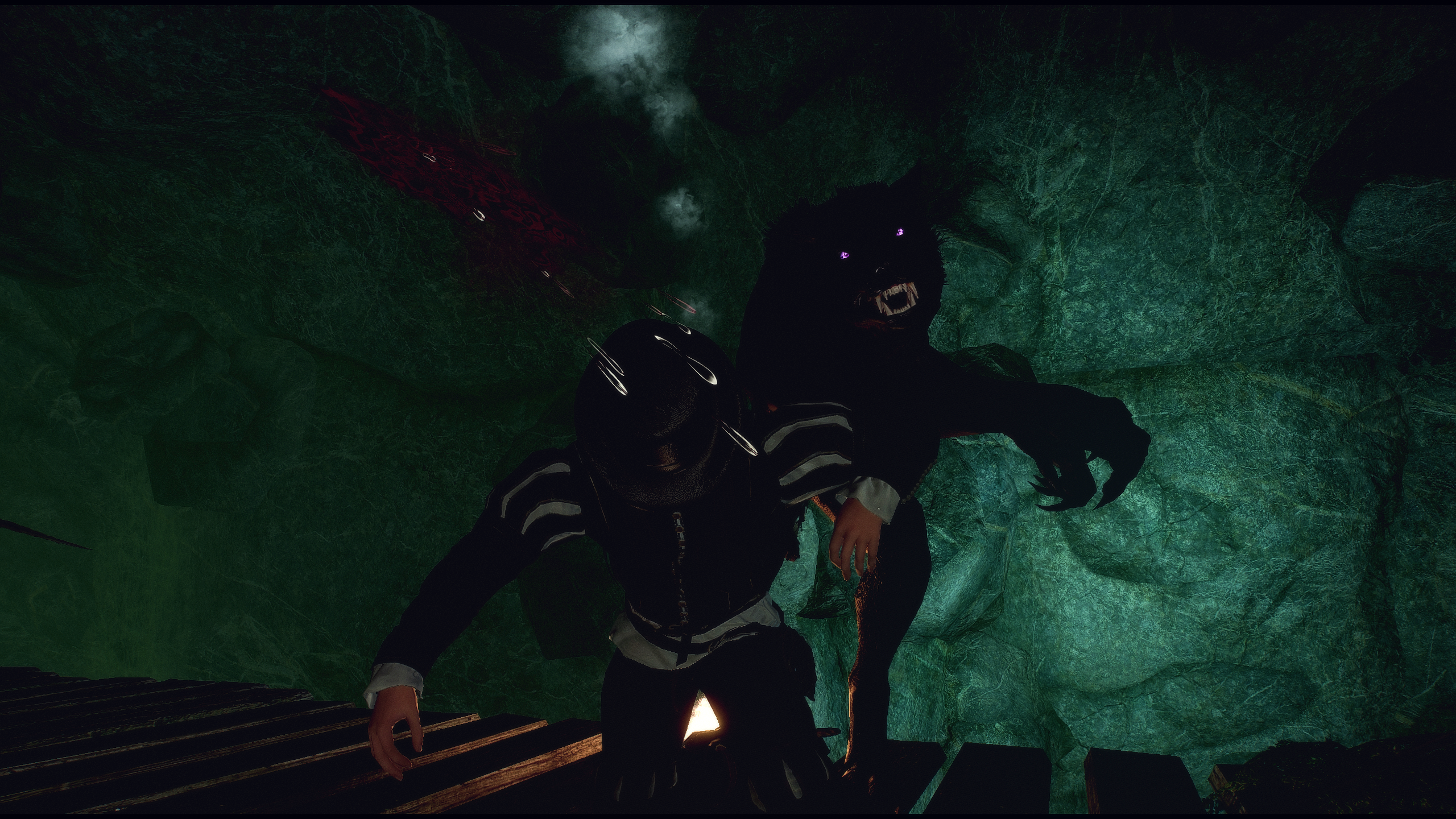
As stated earlier, combat in Somnium is dangerous. Low level characters are fragile, and death will come quickly. As you level up, explore, and find/make better gear you will quickly rise in power.
There are a lot more options available to characters from the get-go than they would have in default Enderal. You can dodge away from, or around, enemy attacks now, giving a powerful defensive technique to every character that can make even low-level characters capable if the player knows how to use it. Beware that dodging uses precious stamina and, as such, should be employed strategically.
Early Game
When your character is just starting out you have everything against you. It is the coinciding moment where you have the least game-knowledge, the lowest skills, the fewest perks, the least talents, and the weakest gear. But you will quickly begin to fix all of these even as you explore the starting area.
There are three core goals of the early game:
- Experiment with the weapons and armor you find.
- Be frugal with your use of magic and healing potions i.e. things that inherently increase your Arcane Fever.
- Don't be afraid to get your teeth kicked in a few times while fighting the enemies and in the never-ending combat with the Arcane Fever.
Because Enderal does not use the typical Skyrim style of character growth, where skills are only raised with use, all characters are free allocate their skill points however they see fit and make use of a variety of weapons and tools to get the job done without fear of missing the experience gain in their primary skills.
The early game will mostly be made up of learning experiences, both in the way of mastering the combat, and in learning the patterns of the Anomalies. And this is fine. Number two exists to incentivize keeping your Arcane Fever low. It does not ask that you never use your spells, but instead to use them intelligently. Maybe plan to get into most fights using none of your magic and powers for the first go so that you can learn more about the enemies. Then you can come back, armed with that knowledge and your spells/potions to win the fight.
With the respawn mechanics, death is not as much an inhibitor to progress. No progress is ever lost, not even the damage you deal to the enemies' health. Instead, it allows you to quickly regroup and strategize better angles to approach a camp from, or better tools to bring with you when you go back to that dungeon. Or, if your foes are located near a reliquary, "throwing yourself" at them is an entirely viable option. So long as your fever is kept low, death is mostly a time setback. Plus, you are given a few Memories of Life as you explore and seek out reliquaries, so you can safely know you'll be able to recuperate your Humanity a few times if you do end up dying a lot with a high fever level.
Firearms
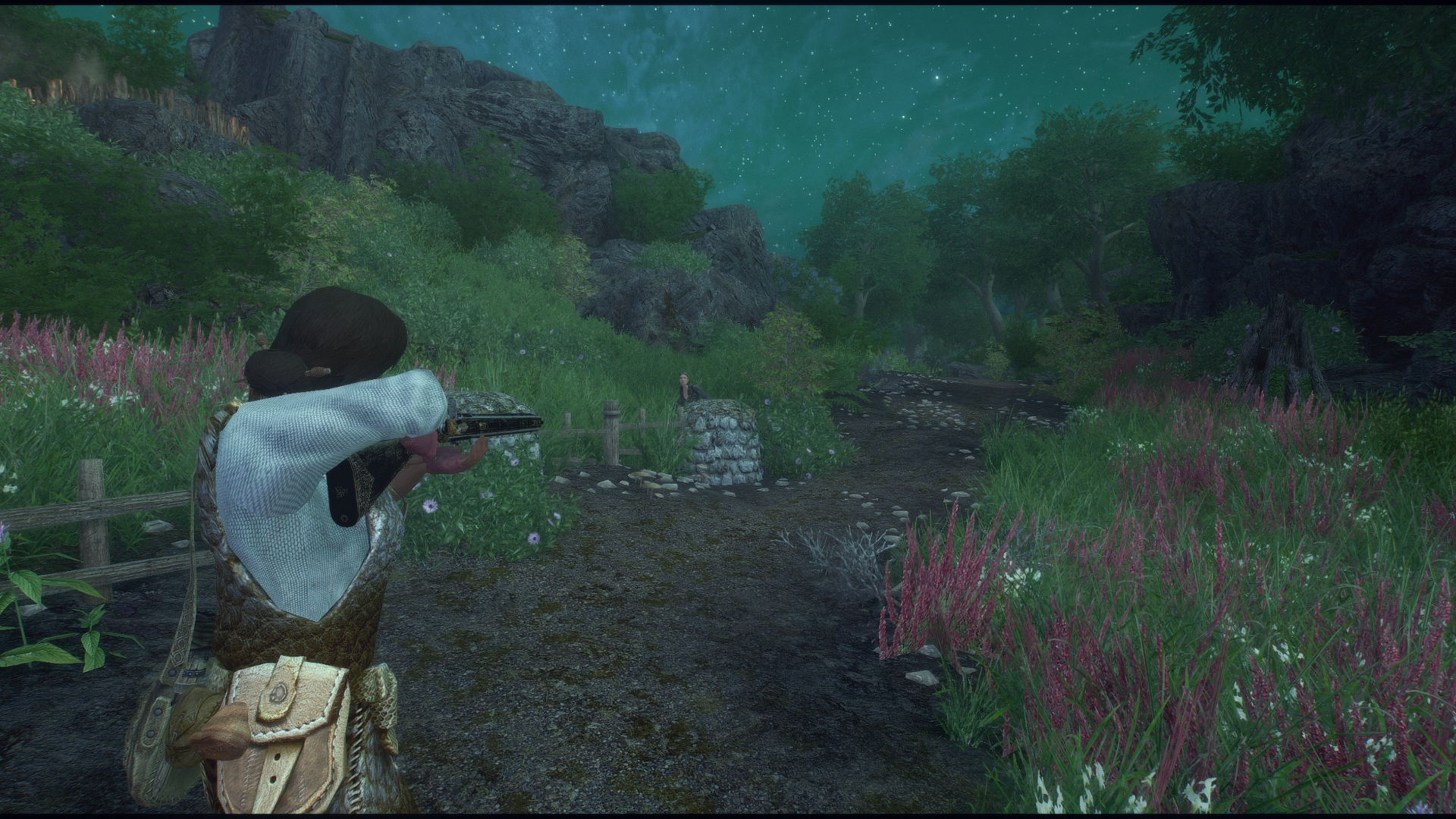
You should find an example of each basic firearm archetype before you even fully depart from the starting temple and valley.
Guns give characters a very powerful ranged option so long as they have the ammunition. Even without perks, these weapons work great as an opener for any character build. While exploring, even a mage-based character could make use of a pistol to kill minor targets without needing to cast their spells and therefore build up their fever even further.
And not only can any character make use of guns, but they are encouraged to do so. Somnium plays, in many ways, like a shooter. The inclusion of guns fundamentally alters the expectations of engagements.
Melee Weapons
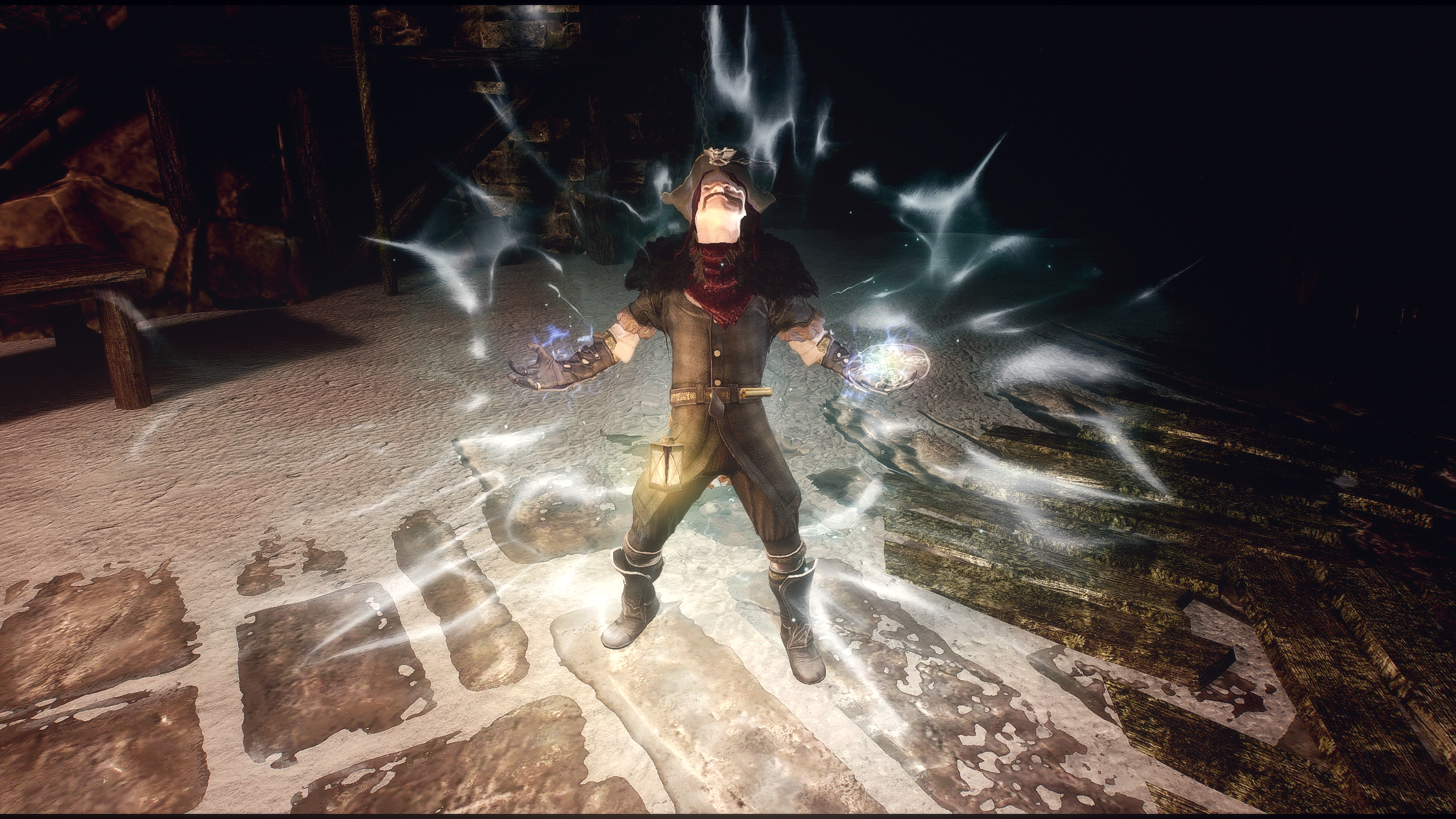
In Somnium, melee combat has advanced as the world has progressed to a more civilized age. You will only find very few have maces, warhammers or war axes left in the world. Instead, most melee weapons now belong to four main types: Thrusting swords, Curved swords, Katanas and Straight Swords (along with daggers for people of less repute). The movesets for these weapons have become much more elegant, allowing for multi-hit combos, pirouettes and quick hits after a well-timed dodge. Experiment with each weapon type and discover for yourself what combat style suits you.
Each weapon type does have unique properties that can be used strategically depending on the enemy you are facing:
Rapiers, or thrusting swords, are the fastest and lightest weapons and have the lowest base damage, but are strong against enemies that wear dense layers of heavier armor and have a longer reach.
Curved swords are of average weight and damage and, due to their shape, are able to be swung faster and can cause bleeding with the right knowledge. However, they are weak against dense, heavy armor and have a shorter reach.
Straight swords are of above average weight and damage but swing more slowly. They do not have an inherent weakness or bonus against heavy, padded armors.
Katanas are, on average, the heaviest weapons in Somnium and carry the highest base damage. They can also bleed enemies but their combat style, especially for the largest of them, requires careful planning as each attack will potentially put the player out of optimal battlefield position.
Lastly, there are different variants of each of the above weapon types, ranging from dagger-sized thrusting stilettos and small, fast katanas called tantos to giant, curved sarass swords favored by the island nation of Kile and large, heavy claymores. All of the melee weapons in Somnium can be switched from a one-handed to a two-handed grip to allow for even more flexibility during combat (Default key: double tap Alt).
Talents

In the 1.2 update, we have completely revamped how players will interact with the talents they accumulate as their character grows. Previously, each talent had an associated arcane fever cost and a unique cooldown that could be lowered with increasing perk investment. Now, players will have a pool of charges that they can spend to use talents, with most talents costing 3 charges at their base level. Investing into higher tiers of the talent will lower the charge cost, down to 1 charge for most talents at their max level. Players will start the game with 8 charges to use as they see fit, and these charges will replenish at the beginning of every new day.
Several things to note:
- not all talents are included in this system, namely Augury, Open Rift, Well of Life and Elemental Attunement. These talents function as they did in version 1.1.
- The player begins the game with eight charges, but players can increase their total pool by hunting down powerful enemies and using their memories.
- Players will also gain three additional charges when they progress enough to choose an affinity.
- Not all talents cost 3 charges at the first tier, with some of the more powerful talents costing more charges. These talents will generally still reduce in cost with higher tiers of investment.
Poise

The type of armor a player wears and the weapons that they use are now more important than ever before. We have implemented a fully customized poise system into Somnium 1.2 that will fundamentally change how players engage in combat. Details will be listed below but the visual representation of your poise is represented in the small bar above the three-stat bar, as seen in the image above. This bar will reduce as your poise is damaged, with increasing flinching occuring as your poise health decreases, and ultimately experiencing a full stagger if the bar is emptied. Poise health will reset to full if you can avoid getting hit for 5 seconds and all of the poise mechanics also apply to your enemies, so plan your engagements strategically.
Players and NPCs that wear heavy armor will have poise health that scales with their equipped weight, level, Heavy Armor skill and armor rating. Heavy armor poise functions as described above, with poise health taking damage as the player takes damage and recovering after not being hit for a short time. Players wearing heavy armor and fully investing in it should be able to shrug off light blows with ease and approach enemy wild mages with a bit more confidence.
Players and NPCs that wear light armor will also have a much lower poise health and will be unable to tank incoming hits with interruption. However, light armor affords both players and NPCs hyperarmor, significantly decreasing the poise damage taken while performing certain actions such as attacking or casting a spell. The amount of poise damage reduced during actions scales dramatically with light armor skill, allowing an agile player that has heavily invested in it to shrug off most blows while attacking.
The ability of the player and NPCs to deal poise damage with melee weapons is dependent on both the weight of the weapon, the amount of damage dealt and how much power is put into the attack, allowing for both to deal more poise damage naturally as the game progresses. More specifically, melee weapon types in Somnium have unique poise damage modifiers, with poise damage increasing low-to-high as follows: daggers, curved swords, katanas, thrusting swords, straight swords. Poise damage dealt by both firearms and magic is based on how damaging the blow is and poise damage can be reduced, but not eliminated, by blocking. To counter enemies that are highly aggressive, a timed bash during an attack will cause a significant amount of poise damage.
Lastly, we have reworked and updated all armor weights and armor rating values, along with all weapon weights and base damage to all fit within the above system.
Magic

Magic was always a major theme and feature of Enderal's world. But in Somnium, the interesting quirks of Enderal's magic lore have been brought into focus.
Arcane Fever
Enderal introduced the idea of the Arcane Fever, however Somnium fully commits to it. For every spell, the aspiring arcanist must first reach for the effect across the infinity that is the Sea of Eventualities. They do this with the new magic talent: Augury. This talent allows for a character to prepare spells in a system inspired by old Vancian magic systems.
Using this talent to prepare spells opens up the player to increases in Arcane Fever with every spell prepared, but it also reduces the prepared spells' cost and drastically increases your mana regeneration. The fever, therefore, is a necessary evil (or in certain cases a boon) for any aspiring mage and is something that is not avoidable. Additionally, some spells, those that deal in the more personal invitations to the Sea, cause a constant uptick of this fever for as long as they are active. Also be aware that as the fever increases, so does the likelihood that a spell will fail outright when cast.
As prospective wizards evolve and improve in their chosen magic schools, they will start to find unique ways their mastery allows for them to interact with this Vancian system. Elementalists might be able to focus into a random element for a time, allowing them to channel those spells without fever cost if they can ride that wave. And those drawn to the Sinistrope may be able to make some sinister bargain allowing them to spend their own humanity in place of their Fever. While Thaumaturges can manipulate the Fever directly, either by lowering it, or "slowing its rise".
And of course, this fever is fueled further by imbibing any potions touched by magic and by proximity to residual magic energy in the world.
The ability to reduce your fever is also more challenging than it was in Enderal. You'll find ambrosia now weighs more and its effect on your fever has been lessened. Powerful alchemists will still be able to push the usefulness of ambrosia further, and now the potency will be noticeably better than purchased vials.
Characters are expected to be suffering from the effects of the fever as they progress through the game. The reasons and goals of this will be expanded on in the Atmosphere section. As a result of this, your character will not suffer the negative stat effects of the fever as it compounds, instead there are a variety of new gameplay alterations that the fever controls.
With the 1.2 update, we have added an additional strategic layer to mage gameplay. Peaceweed has now been touched by the Sea of Eventualities, altering its properties and revealing all new functions that open the mind of the mage even further. Now, players can smoke one portion of peaceweed to temporarily reduce their arcane fever by a small amount. More importantly, while under the influence, players' spells will no longer fail regardless of their Arcane Fever level. This effect last until the player dies or sleeps. Beware however, if you die while under the effects of peaceweed the Arcane Fever that you initially reduced will rebound on you two-fold.
Spell Expansion
The number of spell effects have been greatly increased in Somnium as well. Players will find a vast array of spells to use for each magical discipline.
Players will find offensive Light Magic spells that will help them to better combat the Lost Ones, effective touch spells for the battlemage clad in heavy armor to use, and many more.
With all of these, magic becomes a very effective and versatile skill set for the players that want to walk the line, or even utilize their bond, with their Arcane Fever.
Entropy Rework and New Summon Mechanics
With the 1.1 update, Somnium recieved the largest overhaul of summon mechanics in Skyrim modding to date -- Apoapse's Accomplices. With it, the player no longer has access to distinct summon spells for different creatures – rather, the basic tool in your arsenal is the new talent Open Rift, available halfway up the Entropy tree. Open Rift opens a link to the Sea of Eventualities, bringing forth an otherworldly creature depending on location, skill, active effects, time of day, Arcane Fever level and more. We’ve introduced more than eight times the number of unique summons from vanilla Enderal, so there’s plenty of exploring to do!
Now, this is only a fraction of what Accomplices does. For one, since Open Rift is so taxing, you won’t have to cast it all the time. Rather, each summon sticks around until killed, and each summon provides unique skill benefits when in your party. As such, finding appropriate summons – and keeping them alive throughout your adventure – is the new name of the game in Entropy.
To keep summons alive, you’ll need to make use of the newly expanded Entropy school. Instead of summon spells, the Entropy school is full of spells to affect summons in unique ways: teleport them around the battlefield or store them in a pocket dimension, absorb their taken damage onto yourself, grant them extra lives, and much more.
Lastly, in 1.0 we completely overhauled the summon weapon mechanics of Enderal, resulting in simultaneously more flashy and more functional bound weapon gameplay. Now, in 1.2, we have finally made the summoning of bound weapons affordable for the aspiring battlemage that wants to wade into the fray wielding a blade pulled directly from another eventuality.